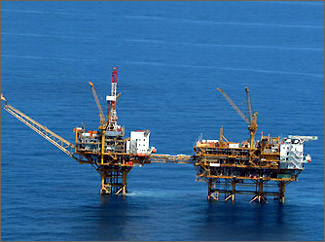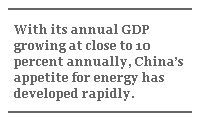East Asia’s Troubled Waters – Part I
East Asia’s Troubled Waters – Part I

EDMONTON, Canada: According to unconfirmed Japanese press reports, a Chinese deep-sea drilling platform in East China Sea has started pumping natural gas. The move rang alarm bells in Japan because the place borders disputed economic zones of the two countries. The rising temperature in this confrontation has again brought to the surface tension that has been boiling for some time. And if proof were necessary, the latest tension shows the unpredictable consequences of globalization and increased interdependence.
The latest spat goes back to the original dispute over Beijing’s and Tokyo’s claimed sovereignty over the Diaoyu islands – or Senkaku in Japanese, and their declared Exclusive Economic Zones that overlap in the East China Sea. Establishing diplomatic relations in 1972, the two nations agreed to shelve the controversy for future negotiations. Deeply shocked by the first oil crisis of 1971, the Japanese government listed diversification of energy sources as a national security priority throughout the 1970s. Soon after the establishment of official ties, China began exporting crude to Japan.

When China opened its door to foreign investment and foreign aid in 1978 as part of its overall economic reform, Tokyo immediately extended low-interest loans in the form of official development assistance (ODA) to Beijing. This provided much-needed foreign capital for China’s modernization drive in its initial stage, and symbolized Japan’s gratitude to Beijing for not seeking war compensation. During the first five-year disbursement of yen loans, the Japanese government selected six large infrastructure projects that directly benefited Chinese export of coal and oil to Japan. By 1983, during negotiation of the second five-year yen loan package, world energy prices had fallen sharply and Tokyo rejected Chinese funding requests for projects related to coal extraction.
Japan’s ODA to China was part and parcel of its energy security policy. After becoming a net oil importer in 1993, China continued to supply Japan with good-quality, low-cost crude from its Northeast Daqing Oil Fields, only stopping in early 2004 when the two sides could not agree over prices. At the same time, China, with its own energy in serious short supply, overtook Japan as the second largest energy consumer in the world. Since the early 1990s, Japan substantially decreased ODA to China, with total suspension expected soon.

The process of China and Japan moving from being complementary partners to competitors in the energy area has also been accompanied by increasing confrontation in the East China Sea. With its annual GDP growing at close to 10 percent annually during the past 25 years, China’s appetite for energy has developed rapidly. Since the early 1990s, China’s National Offshore Oil Corporation (CNOOC) has explored for oil and natural gas in the East China Sea. Now, a number of CNOOC gas projects are reportedly near completion and could go into production soon. Although the projects are on the Chinese side of Japan’s claimed median line – not acknowledged by Beijing – Tokyo insists that the gas deposits on the Japanese side could drain away once the Chinese begin extraction under the seabed.
The Japanese response has been to create an awareness campaign. The Japanese media report every Chinese move, the Japanese government has assigned Japanese names to the CNOOC gas fields, the parliament passed legislation that grants Japan’s private companies the right to drill in the disputed area, Japanese military airplanes make routine flights to monitor progress of CNOOC projects, Tokyo has put this year’s ODA to China on hold over the dispute, and hawks in the ruling Liberal Democratic Party demand that the country back up Japanese explorations in the region with military force.
Beijing, on the other hand, has warned Tokyo that any Japanese drilling activities in the disputed area would constitute a serious provocation against China’s sovereignty and that Tokyo must bear responsibility for the consequences. The threats, not subtle, increase the potential for serious escalation.

As much as confrontation has turned into a game of chicken, both sides know how much of their future is at stake. So they continue trying to find a diplomatic solution. After four rounds of negotiations, the two parties are not close to a resolution. In diplomatic language, both countries say that they hope to cooperate with each other, conducting joint exploration and sharing the region’s resources. But in reality, the two parties have different definitions for the term “joint-exploration.”
To Japan, it means that China must stop current projects, turn over all existing geological data to Tokyo before both sides can share the potential resources of the region, including the gas fields developed by CNOOC on the Chinese side of Japan’s own declared median line. The Chinese find such demands unacceptable, with Beijing interpreting “joint-exploration” as Japan not interfering with any current Chinese development on the Chinese side, even according to Japan’s median line. Instead, China agrees to share resources found in the disputed area between the two median lines claimed by Tokyo and Beijing. In the latest round of talks, China noted that the agreement must include the disputed Senkaku/Diaoyu Islands region.
With the talks stalled, Japan is under intense domestic pressure to make its own moves. Unconfirmed reports say that one of the Chinese gas fields, Chunxiao, is either ready to send gas back to China or already doing so without formal announcement; and the Chinese Maritime Bureau’s notice to prohibit the passage of ships in the area of another gas field further fuels Japanese anxiety. As one recent Japan Times headline put it, “Time for Japan to shut up and drill.”

Ironically, economic interdependence of the two neighbors deepens daily, with unprecedented flows of goods, investments, and joint-ventures in both directions. But polls indicate that over the past 25 years a majority in each country reports a progressively negative image of the other. Top leaders from Beijing and Tokyo have not visited each other for five years; political tensions are mounting and efforts to ease them have so far failed.
A major obstacle to a better relationship is the lack of reconciliation more than 60 years after the Second World War. Japanese Prime Minister Junichiro Koizumi has insisted on worshiping annually at the Yasukuni Shrine where convicted war criminals are buried among the war dead.
The “history question” may hinder friendly ties between Japan and China, but probably would not cause a military conflict In a world of diminishing resources, estimates have 200 trillion cubic feet of potential gas reserves and up to 100 billion barrels of oil deposits on the entire shelf of the East China Sea – and that is where the danger of miscalculation and deadly escalation lie.
The reserves, close to both Japan and China, could provide a long-term, secure supply to both countries if a cooperative solution is worked out. But the complex interdependence between Beijing and Tokyo has created an economic security dilemma: One country’s drive to secure its own energy supply has turned into a real or perceived depletion of the other’s potential resources. With all the ill feelings, the most challenging task for both countries is how to prevent hardliners from hijacking the bilateral agenda, putting the two giant neighbors on a road of collision rather than cooperation.
Wenran Jiang is the director of China Institute at the University of Alberta and a senior fellow at the Asia Pacific Foundation of Canada. The views expressed here are his own.